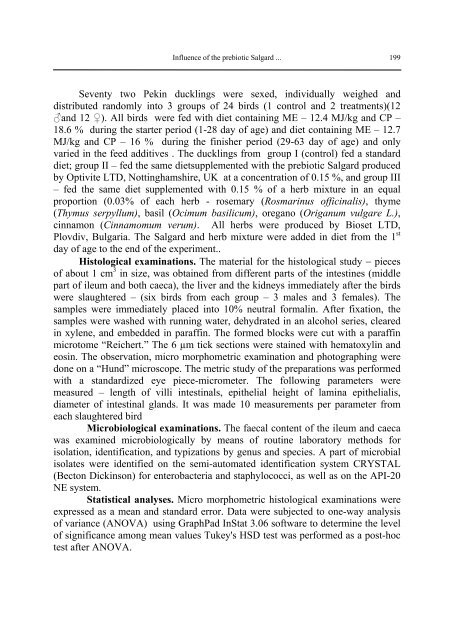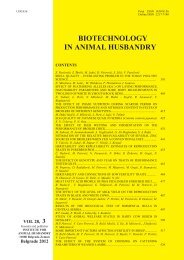Biotechnology in Animal Husbandry - Institut za Stočarstvo
Biotechnology in Animal Husbandry - Institut za Stočarstvo
Biotechnology in Animal Husbandry - Institut za Stočarstvo
Create successful ePaper yourself
Turn your PDF publications into a flip-book with our unique Google optimized e-Paper software.
Influence of the prebiotic Salgard ...<br />
Seventy two Pek<strong>in</strong> duckl<strong>in</strong>gs were sexed, <strong>in</strong>dividually weighed and<br />
distributed randomly <strong>in</strong>to 3 groups of 24 birds (1 control and 2 treatments)(12<br />
♂and 12 ♀). All birds were fed with diet conta<strong>in</strong><strong>in</strong>g ME – 12.4 MJ/kg and CP –<br />
18.6 % dur<strong>in</strong>g the starter period (1-28 day of age) and diet conta<strong>in</strong><strong>in</strong>g ME – 12.7<br />
MJ/kg and CP – 16 % dur<strong>in</strong>g the f<strong>in</strong>isher period (29-63 day of age) and only<br />
varied <strong>in</strong> the feed additives . The duckl<strong>in</strong>gs from group I (control) fed a standard<br />
diet; group II – fed the same dietsupplemented with the prebiotic Salgard produced<br />
by Optivite LTD, Nott<strong>in</strong>ghamshire, UK at a concentration of 0.15 %, and group III<br />
– fed the same diet supplemented with 0.15 % of a herb mixture <strong>in</strong> an equal<br />
proportion (0.03% of each herb - rosemary (Rosmar<strong>in</strong>us offic<strong>in</strong>alis), thyme<br />
(Thymus serpyllum), basil (Ocimum basilicum), oregano (Origanum vulgare L.),<br />
c<strong>in</strong>namon (C<strong>in</strong>namomum verum). All herbs were produced by Bioset LTD,<br />
Plovdiv, Bulgaria. The Salgard and herb mixture were added <strong>in</strong> diet from the 1 st<br />
day of age to the end of the experiment..<br />
Histological exam<strong>in</strong>ations. The material for the histological study − pieces<br />
of about 1 cm 3 <strong>in</strong> size, was obta<strong>in</strong>ed from different parts of the <strong>in</strong>test<strong>in</strong>es (middle<br />
part of ileum and both caeca), the liver and the kidneys immediately after the birds<br />
were slaughtered – (six birds from each group – 3 males and 3 females). The<br />
samples were immediately placed <strong>in</strong>to 10% neutral formal<strong>in</strong>. After fixation, the<br />
samples were washed with runn<strong>in</strong>g water, dehydrated <strong>in</strong> an alcohol series, cleared<br />
<strong>in</strong> xylene, and embedded <strong>in</strong> paraff<strong>in</strong>. The formed blocks were cut with a paraff<strong>in</strong><br />
microtome “Reichert.” The 6 µm tick sections were sta<strong>in</strong>ed with hematoxyl<strong>in</strong> and<br />
eos<strong>in</strong>. The observation, micro morphometric exam<strong>in</strong>ation and photograph<strong>in</strong>g were<br />
done on a “Hund” microscope. The metric study of the preparations was performed<br />
with a standardized eye piece-micrometer. The follow<strong>in</strong>g parameters were<br />
measured – length of villi <strong>in</strong>test<strong>in</strong>als, epithelial height of lam<strong>in</strong>a epithelialis,<br />
diameter of <strong>in</strong>test<strong>in</strong>al glands. It was made 10 measurements per parameter from<br />
each slaughtered bird<br />
Microbiological exam<strong>in</strong>ations. The faecal content of the ileum and caeca<br />
was exam<strong>in</strong>ed microbiologically by means of rout<strong>in</strong>e laboratory methods for<br />
isolation, identification, and typi<strong>za</strong>tions by genus and species. A part of microbial<br />
isolates were identified on the semi-automated identification system CRYSTAL<br />
(Becton Dick<strong>in</strong>son) for enterobacteria and staphylococci, as well as on the АPI-20<br />
NE system.<br />
Statistical analyses. Micro morphometric histological exam<strong>in</strong>ations were<br />
expressed as a mean and standard error. Data were subjected to one-way analysis<br />
of variance (ANOVA) us<strong>in</strong>g GraphPad InStat 3.06 software to determ<strong>in</strong>e the level<br />
of significance among mean values Tukey's HSD test was performed as a post-hoc<br />
test after ANOVA.<br />
199




